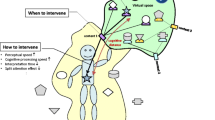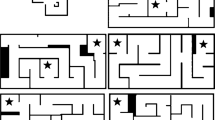Abstract
We developed a fully simulated dual-task paradigm to be used in virtual environment studies implying both eye-head coordination and an increased workload. We utilized a physical smartphone for favoring an authentic touch and haptic feedback, and a free walk on a treadmill, without any imposed control system, to closely replicate real-world postural behavior while facilitating natural walking. These simple and natural tasks may play a key role in future vision sciences studies.
Access this chapter
Tax calculation will be finalised at checkout
Purchases are for personal use only
Similar content being viewed by others
References
Boulanger, M., Giraudet, G., Faubert, J.: Interaction between the oculomotor and postural systems during a dual-task: compensatory reductions in head sway following visually-induced postural perturbations promote the production of accurate double-step saccades in standing human adults. PLoS ONE 12(3), e0173678 (2017). https://doi.org/10.1371/journal.pone.0173678
Courtemanche, F., et al.: Texting while walking: an expensive switch cost. Accid. Anal. Prev. 127, 1–8 (2019)
Craig, C.M., Tian, D., Morris, N.L.: Task-relevant smartphone messages within work zones: a driving simulation study. Hum. Factors 66, 1786 (2023). https://doi.org/10.1177/00187208231167641
Crowley, P., et al.: The effects of walking speed and mobile phone use on the walking dynamics of young adults. Sci. Rep. 11, 1237 (2021)
Faubert, J., Allard, R.: Effect of visual distortion on postural balance in a full immersion stereoscopic environment. In: Proceedings of SPIE 5291, Stereoscopic Displays and Virtual Reality Systems XI (2004). https://doi.org/10.1117/12.527017
Fox, E., Houpt, J., Tsang, P.: Derivation and demonstration of a new metric for multitasking performance. Hum. Factors 63, 18720820951089 (2020). https://doi.org/10.1177/0018720820951089
Hanssens, J.-M., Allard, R., Faubert, J.: Progressive lenses distortions effect on postural stability in virtual reality environment. J. Vis. 7(9), 1026 (2007). https://doi.org/10.1167/7.9.1026
Horrey, W.J., Wickens, C.D.: Examining the impact of cell phone conversations on driving using meta-analytic techniques. Hum. Factors J. Hum. Factors Ergonom. Soc. 48(1), 196 (2006)
Ang, K.H., Chong, G., Li, Y.: PID control system analysis, design, and technology. IEEE Trans. Control Syst. Technol. 13(4), 559–576 (2005). https://doi.org/10.1109/TCST.2005.847331
Kim, J., et al.: A user-driven treadmill control scheme for simulating overground locomotion. In: Conference proceedings: Annual International Conference of the IEEE Engineering in Medicine and Biology Society (2012)
Krasovskya, T., Weissa, P.L., Kizonya, R.: A narrative review of texting as a visually-dependent cognitive-motor secondary task during locomotion. Gait Posture 52, 354–362 (2017)
Lichtenstein, L., et al.: A feedback-controlled interface for treadmill locomotion in virtual environments. ACM Trans. Appl. Percept. 4(1), 7 (2007). https://doi.org/10.1145/1227134.1227141
Lim, J., et al.: Dual task effect on visual perception and walking stability. J. Exerc. Rehab. 13(1), 48–54 (2017)
Olga, L.-S., Siegfried, W., Katharina, R.: Augmentation impacts strategy and gaze distribution in a dual-task interleaving scenario. Int. J. Hum. Comput. Interaction 38(4), 383–394 (2022). https://doi.org/10.1080/10447318.2021.1948250
Marin, G., et al.: Validation of a lens simulator in virtual reality. In: 3rd European Meeting in Physiological Optics, City University, London (2006)
Marin, G., et al.: Compared distortion effects between real and virtual ophthalmic lenses with a simulator. In: 15th ACM Symposium on Virtual Reality Software and Technology, Bordeaux, France (2008)
Marin, G., et al.: Measure of individual eye-head coordination compared in real and virtual environment. In: International Conference in Computer Graphics, Visualization, Computer Vision and Image Processing, Rome, Italy (2011)
Mohler, B.J., Thompson, W.B., Creem-Regehr, S.H., Willemsen, P., et al.: Calibration of locomotion resulting from visual motion in a treadmill-based virtual environment. ACM Trans. Appl. Percept. 4(1), 4 (2007). https://doi.org/10.1145/1227134.1227138
Patoine, A., et al.: Increased visual and cognitive demands emphasize the importance of meeting visual needs at all distances while driving. PLoS ONE 16(3), e0247254 (2021)
Prudence, P., Sarah, A., Colleen, D., Eliza, K.: Texting and walking: effect of environmental setting and task prioritization on dual-task interference in healthy young adults. Gait Posture 41–1, 46–51 (2015)
Pozzo, T., Berthoz, A., Lefort, L.: Head stabilization during various locomotor tasks in humans I. Normal subjects. Exp. Brain Res. 82, 97–106 (1990)
Prochaczek, F., Jacek, S., et al.: The six-minute walk test on the treadmill. In: Chronic Obstructive Pulmonary Disease - Current Concepts and Practice (2012)
Souman, J.L., et al.: Making virtual walking real: perceptual evaluation of a new treadmill control algorithm. ACM Trans. Appl. Percept. 7(2), 1 (2010). https://doi.org/10.1145/1670671.1670675
Schwebel, D.C., Stavrinos, D., Byington, K.W., Davis, T., O’Neal, E.E., de Jong, D.: Distraction and pedestrian safety: how talking on the phone, texting, and listening to music impact crossing the street. Accid. Anal. Prev. 45, 266–271 (2012)
Ziegler, J.G., Nichols, N.B.: Optimum settings for automatic controllers. Trans. ASME 64(11), 759 (1942)
de Aquino Costa Sousa, T., Gagnon, I.J., Li, K.Z., McFadyen, B.J., Lamontagne, A.: Exploring the challenges of avoiding collisions with virtual pedestrians using a dual-task paradigm in individuals with chronic moderate to severe traumatic brain injury. J. Neuroeng. Rehab. 21(1), 80 (2024)
Bhojwani, T.M., Lynch, S.D., Bühler, M.A., Lamontagne, A.: Impact of dual tasking on gaze behaviour and locomotor strategies adopted while circumventing virtual pedestrians during a collision avoidance task. Exp. Brain Res. 240(10), 2633–2645 (2022)
Bovim, L.P., Gjesdal, B.E., Mæland, S., Aaslund, M.K., Bogen, B.: The impact of motor task and environmental constraints on gait patterns during treadmill walking in a fully immersive virtual environment. Gait Posture 77, 243–249 (2020)
Mousas, C., Kao, D., Koilias, A., Rekabdar, B.: Evaluating virtual reality locomotion interfaces on collision avoidance task with a virtual character. Vis. Comput. 37, 2823–2839 (2021)
Soni, S., Lamontagne, A.: Characterization of speed adaptation while walking on an omnidirectional treadmill. J. Neuroeng. Rehabil. 17, 1–11 (2020)
Bashir, A., De Regt, T., Jones, C.M.: Comparing a friction-based uni-directional treadmill and a slip-style omni-directional treadmill on first-time HMD-VR user task performance, cybersickness, postural sway, posture angle, ease of use, enjoyment, and effort. Int. J. Hum. Comput. Stud. 179, 103101 (2023)
Lewis, M.M., et al.: Gait patterns during overground and virtual omnidirectional treadmill walking. J. Neuroeng. Rehabil. 21(1), 29 (2024)
Acknowledgments
Authors greatly acknowledge reviewers for their valuable and useful comments.
Author information
Authors and Affiliations
Corresponding author
Editor information
Editors and Affiliations
Ethics declarations
Disclosure of Interests
G. Marin and D. Tranvouez are employees of Essilor International. N. Berjaud and J. Julien were student of ESIEA in there training period at Essilor International at the time of their participation. M. Le Renard, formerly employee of ESIEA at the time this work started, is CEO of FOKS-lab who has a financial collaboration with Essilor International.
Rights and permissions
Copyright information
© 2025 The Author(s), under exclusive license to Springer Nature Switzerland AG
About this paper
Cite this paper
Marin, G., Berjaud, N., Julien, J., Le Renard, M., Bernardin, D. (2025). A Fully Immersive Dual-Task Using a Smartphone While Walking in a Virtual Reality Environment. In: Reyes-Lecuona, A., et al. Virtual Reality and Mixed Reality. EuroXR 2024. Lecture Notes in Computer Science, vol 15445. Springer, Cham. https://doi.org/10.1007/978-3-031-78593-1_1
Download citation
DOI: https://doi.org/10.1007/978-3-031-78593-1_1
Published:
Publisher Name: Springer, Cham
Print ISBN: 978-3-031-78592-4
Online ISBN: 978-3-031-78593-1
eBook Packages: Computer ScienceComputer Science (R0)




